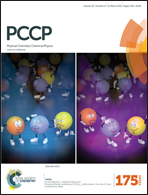The growth mechanism and ferroelectric domains of diisopropylammonium bromide films synthesized via 12-crown-4 addition at room temperature†
Abstract
Diisopropylammonium bromide (DIPAB) has attracted great attention as a molecular ferroelectric with large spontaneous polarization and high Curie temperature. It is hard to grow the ferroelectric phase DIPAB because of the appearance of the non-ferroelectric phase DIPAB at room temperature. Here, a ferroelectric thin film of DIPAB was successfully fabricated on a Si substrate using a spin coating method from aqueous solution via 12-crown-4 addition at room temperature. The ferroelectric DIPAB film with a thickness of hundreds of nanometers is distributed discontinuously on the substrate in narrow strips. The direction of polarization is along the narrow strip. Piezoresponse force microscopy (PFM) shows that the ferroelectric films have two kinds of domain structures: noncharged antiparallel stripe domains and charged head-to-head (H–H)/tail-to-tail (T–T) type domains. 12-crown-4 has been proved to play important roles in forming the H–H/T–T type domains. The Chynoweth method shows that the DIPAB films synthesized in this way show a better pyroelectric effect than DIPAB crystals.



 Please wait while we load your content...
Please wait while we load your content...